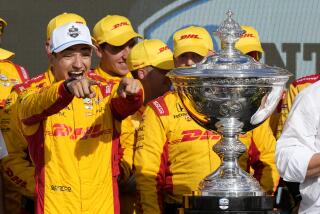Racing Into the Unknown
- Share via
INDIANAPOLIS — Do you know this man?
Probably not.
You should, you know.
This man is the defending Indianapolis 500 champion. He won this venerable race last year, one of only 60 drivers in history to be able to make that statement.
But, he could star in one of those “Don’t leave home without it” credit- card commercials.
Buddy Lazier might have trouble cashing a check anywhere west of Terre Haute. He’s America’s secret champion. You’ve heard of “uncrowned champions?” Well, meet one.
You see, to qualify for the ticker-tape parades, the appearances on “Oprah,” the autograph signings, the book deals, you have to win Indy by beating the marquee names from there. You know. Any Unser. Any Andretti. The occasional Fittipaldi. The registered giants of the Speedway.
Buddy Lazier beat Davy Jones. Richie Hearn. That’s not exactly like winning the title from Jack Dempsey. Dunking over Michael Jordan.
In the ordinary course of things, you would expect Hollywood to be readying “The Buddy Lazier Story” for production. You would expect Jay Leno’s people to be on the phone.
The facts of the matter are, Lazier walked through the pressroom the other day, a facility for guys who spend their lives covering his sport. No one looked up. The autograph hounds look at him uncertainly, then hastily leaf through their race guides to see who he is.
The problem is, the race that Lazier won, the drivers could have been wearing masks and not been more anonymous.
It was the first salvo in the war between Indianapolis’ Tony George and the racing establishment. He modified the rules dramatically, not to keep the riff-raff out but to keep the elite out.
Look at it this way: Those of us in sports are used to the great names phasing out over their career in the normal attrition of time. A new crop inserts itself seamlessly.
But this attrition took place overnight. It’s as if the management of the Masters golf tournament suddenly announced that their tournament next year would be run not by the USGA but by a home-grown group, the Masters Golfing League, and players such as Tiger Woods and Nick Faldo would not be eligible. Would that Masters champion make David Letterman’s show? Get a multimillion-dollar contract from Nike?
So, the notion persists that Buddy Lazier inherited the Indianapolis 500 rather than earned it.
But did he?
First of all, Lazier paid his dues at Indianapolis. He has been around this race course almost as many times as the latest Unser. He’s no stranger to its walls, its fouled air, its rear-end push, its oil slides. He qualified for this race four times. His first race, he didn’t even make the first turn, slicing the nose off his car trying to avoid a sliding car alongside.
The next year, he managed 139 laps before his engine quit. In 1995, he made 45 laps before his fuel system clogged.
You don’t just climb out of a dirt car and suit up and win Indy. Only five rookies have ever won this thing--six, if you include Ray Harroun, who won the first one. You don’t just attack this track. It gets resentful. You have to romance it. Schmooze a little.
Robert Buddy Lazier [Buddy is his real middle name] has been in a race car or on a ski trail since he was born. His family was moving from Minnesota and on its way south to the sun when their car, a Morris Minor, broke down. It was not surprising: They had been selling parts of the car for meal money along the way.
So, they threw the anchor out in Vail, Colo. Young Buddy didn’t know whether to aim for the Winter Olympics or the Indianapolis 500.
His father, Bob Lazier, was a race driver more or less in his spare time. (He also built and opened the Tivoli Lodge in Aspen.) He even qualified for the Indy 500 in 1981. He finished 19th but lasted 154 laps.
Buddy traveled to Super Vee races with his dad and got the smell of methanol in his nostrils and the spell of racing in his veins. From then on, he did his slaloming in a go-cart or a midget. He was hooked.
The trouble was, he did most of his racing in used cars, four-year-old discards, Scotch-tape and chewing gum heaps looking for a wall to hit. It got so he would listen to hear which part would fall off first.
Roger Penske didn’t come calling. Neither did the other checkered-flag magnates. Lazier became one of those middle-of-the-pack race-fillers without whom the game can’t live.
So long as he was in a race, that’s all he cared. “Success is nice,” he tells you. “But I love racing. I’d rather be 20th in a race than not in it at all.”
Does he feel he has been black-flagged by history? The Indy winner nobody knows? Ol’ What’s-His-Name who won the year time forgot?
Lazier, a good-humored sort who doesn’t need a spotlight, just a steering wheel, shakes his head. “I got on the Conan O’Brien show, I get recognized in airports. It amazes me,” he says.
He has now won as many Indy 500s as Parnelli Jones. But whose name is the household word? In this year’s race, there will be only two ex-winners on the grid. He is one of them. Arie Luyendyk is the other. When Luyendyk won (1990) there were 10 former winners in the field.
Lazier wants to know if you think he can win again this year. He is superstitious, like most race drivers, and needs reassurances--like most people.
Well, if he does, he really joins an elite group. Only 15 are multiple winners. Only three won back to back.
If he brings that off, he’ll have to wear dark glasses and a beard in public, change his name to “Tiger”--or see about Kevin Costner for the lead in “The Buddy Lazier Story.”
More to Read
Go beyond the scoreboard
Get the latest on L.A.'s teams in the daily Sports Report newsletter.
You may occasionally receive promotional content from the Los Angeles Times.










